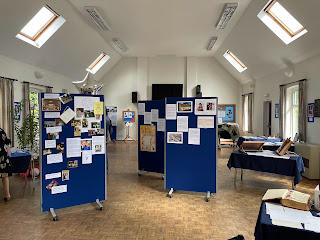My writing on Monkybusiness has always tried to bring in our local experience in the great Abbey here in St Albans. When I do this the text goes into Italics. To conclude my series about Monks and Healthcare I am focusing on leper hospitals in St Albans. There was one for men founded between 1119-46 (St Julian's) and for women founded 1194 (St Mary de Pre). I shall mainly be concentrating on the former because it lay under the modern church of St Bartholomew where I have worshipped over 40 years.
It came as a bit of a shock to me to know that as I practice the organ a community of monks may have chanted the Hours here 900 years ago and lepers may be buried very near. This year we are celebrating a mere 60 years !
We know that Abbot Geoffrey de Gorham of St Albans founded a hospital for lepers in the early 12th century beside the road to London (Watling Street) and the accommodation was on one side of the road with the church on the other. We can get an idea of what the church may have looked like from a contemporary one that survived at Stourbridge near Cambridge.(see below)
Leprosy was all around England at this time. Some
saw it as a punishment from God or as a trial to be undergone. It could lead to
terrible physical affliction with ulcerations, facial disfiguration, blindness
and loss of fingers. It likely covered those with a range of skin complaints
like eczema. Consequently such persons should be kept somewhere apart.
Hospices were being set up across England staffed by monks governed by strict monastic
rules, designed as a home with physical and spiritual help to those labelled as
lepers. They were funded in a variety of ways. Here in St Albans Abbot Geoffrey
arranged for the taxes (known as tithes) from various parishes which owed him
allegiance, to be diverted to its support. These were confirmed and adapted by later
abbots or Papal bull.
The initial 12th century rules have
been lost so we have to deduce how the place was run from the Deeds of the
Abbey and rules issued by the great 14th century abbots Michael de
Mentmore and Thomas de la Mere. Lepers were forbidden to loiter on the road
between the hospital buildings and the church. As St Julian’s Hospital was run
like a monastery with resident monks, the normal eight offices (services) and
Mass would have been celebrated daily starting very early morning. The lepers
would have crossed the road to attend Mass and some of the offices, notably
vespers and compline. They were forbidden to leave the monastery grounds
without permission; to go into the town of St Albans ; to stay away at night or
go into the brewery or bake house. There was a shelter facing the road along
the side of the road where lepers could converse with one another, but were
supposed to be brief and avoid contact
with outsiders. Visitors were allowed to visit a sick person.
In the mid 14th century there should
have been 6 lepers and a community of 5 priests of good character and a master
in charge. The strictness of the rules
suggest that in the past the behaviour of the inmates may have fallen below
what was expected. By the 15th century the prevalence of leprosy had
receded and our hospital had less inmates. Early in the 16th century,
there were disputes about the mastership and it may have ceased to function as a hospital.
The domestic buildings and farm were then operated like any other belonging to
St Albans Abbey.
After the Reformation and dissolution of the abbey in 1539 it passed to Sir Richard Lee of Sopwell, who obtained much of the former Abbey’s land. . Over the following centuries the hospital buildings were dismantled and rebuilt as St Julians farm, which stood where Tithe Barn Close and Robert Avenue are now. The church was no longer required and was demolished. This open space remained until our Church was built 60 years ago.
 |
| St Barts today : 60 years old! |
 |
| Interior |

 |
| Exhibition in our Hall to celebrate 60 years |



No comments:
Post a Comment